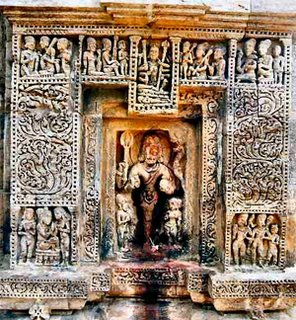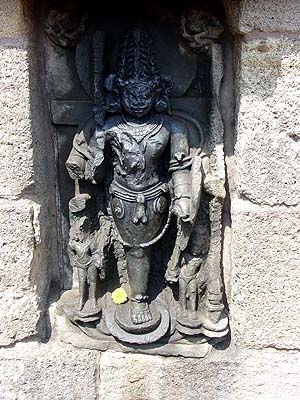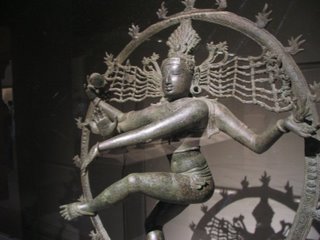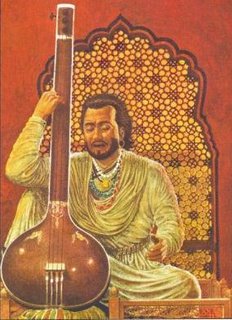
She woke up in cold sweat,
What was that?
All she remembered were those eyes.
A man moved around,
A lightning in the dark, two eyes so powerful
Swept the air as they danced to his beat.
He resounded again...
damadamadama | damadamadama | damadamadum |
damadamadama | damadamadama | damadamadum ||
She stood, silent looking at the sea,
The waves advancing with force washing her feet,
Giving additional rhythm to the drumbeat.
The moon swayed in the night sky,
Tossing among silent clouds
As the wind whistled on.
The mridangam beat reverberated in her mind...
She raised her feet, looked up to the air and called to the Goddess Chamunda.
Oh Mother
Help me perform the very dance,
The dance of fury
The dance of lightning
Those very steps that you walk...
damadamadama | damadamadama | damadamadum |
damadamadama | damadamadama | damadamadum ||
The feet raised, the body moves
The muscles wake up
To the calls of the night
The cat moves in stealth
Chamunda descends
damadamadama | damadamadama | damadamadum |
damadamadama | damadamadama | damadamadum ||
The dimly lit cloudy stage
The wet floor with waves
The slow beat in the waters
A trident gold the goddess awakes
The spirit invoked
damadamadama | damadamadama | damadamadum |
damadamadama | damadamadama | damadamadum ||
The muscles like a panther move
The feet agile, the body smooth
The steps sure, the earth resounds
Sending ripples through the wind
The fury within pours forth
damadamadama | damadamadama | damadamadum |
damadamadama | damadamadama | damadamadum ||
Together the beat, together the step
They yield the trident of death
The eyes glow, the limbs move
The grace within unfolds
The bodies arch back, and then attack
damadamadama | damadamadama | damadamadum |
damadamadama | damadamadama | damadamadum ||
A red glow in pure white skin
The Goddess shimmers in gold
A deadly trident circles around
Her deft hands behold
The power within
damadamadama | damadamadama | damadamadum |
damadamadama | damadamadama | damadamadum ||
The flames light up, the gods descend
The sea recedes and comes forth again
The clouds move, the moon reveals
The bright eyed goddess moves
Crossing the man in rhythmic outburst
damadamadama | damadamadama | damadamadum |
damadamadama | damadamadama | damadamadum ||
Their backs meet, their feet retreat
The tridents move like lightening
Circles of light that never meet
As they unite and depart
The energy within overflows
damadamadama | damadamadama | damadamadum |
damadamadama | damadamadama | damadamadum ||
The tiger moves, in similar step
As she takes her feet through the air
Her grace her light her charm revealed
She moves in fury
Her feet sink in the sand beneath
damadamadama | damadamadama | damadamadum |
damadamadama | damadamadama | damadamadum ||
Such force, the tremors felt
The heart pound the heat rises
Her skin glows, her dress in red
Sways to the wind as she flows
The trident now her halo holds
damadamadama | damadamadama | damadamadum |
damadamadama | damadamadama | damadamadum ||
The gods witness the performer go
The man gives the beat to her feet
Her moves so easy her mind so calm
That sways with such delicacy
Through the shaken air
damadamadama | damadamadama | damadamadum |
damadamadama | damadamadama | damadamadum ||
Such grace unknown, such power not felt
That brings the great gods to earth
Lord Shiva beholds her silent steps
The shastras of bharata unfold
The dance of fury, the dance of vigor
damadamadama | damadamadama | damadamadum |
damadamadama | damadamadama | damadamadum ||
The moon hides, the sea calm
The man bring down the rhythm
The dance concludes the body weakens
Chamunda withdraws from the being
A miracle engulfed into the silence again.
damadamadama | damadamadama | damadamadum |
damadamadama | damadamadama | damadamadum ||

Photo courtesy: Glossary of Indian Art | Shunya.net























